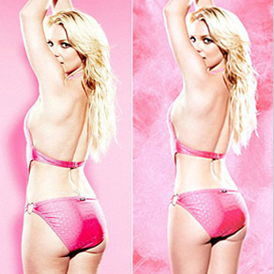Children given lessons in body image
Bombarded by endless pictures of perfect celebrities, the government hopes new body image lessons will help children recognise what they see is not always what is real.

Britney Spears, looking slim and flawless – the perfect image. Or is it? Children aged between 10 and 11 will be shown photographs of the star before and after she was airbrushed, as part of the government’s initiative to promote body confidence in schools.
The government is using a new learning plan drawn up by Media Smart, an organisation funded by the Advertising Standards Authority. The teaching materials include a range of images from the media, designed to show how they can be manipulated, and to “help young people critically appraise and gain more realistic perceptions of the images they see”.
The PowerPoint presentation also includes advertisements from Benetton and Dove, which aim to celebrate people of different races, shapes and sizes.
Their value is worth so much more than their physical appearance. Lynne Featherstone, Equalities Minister
The Equalities Minister Lynne Featherstone, who launched the pack at a primary school in south London, said she wanted children “to recognise from an early age that their value is worth so much more than their physical appearance”.
Constant bombardment
There has been a growing campaign to help young people resist the constant bombardment of idealised images of celebrities, at a time when rates of eating disorders are rising, and affecting children as young as five.
Tackling advertising is just one approach: the writer Susie Orbach has acknowledged that it is “crucial” for children and their parents to recognise the often negative impact of airbrushed images and “see the differences between the real and the fantastical”.
The television presenter Gok Wan has also been campaigning for body confidence issues to be taught in schools. He presented a full teaching plan to the last Schools Secretary Ed Balls, in 2009, but could not get a policy in place before the general election.
He has now started a new campaign to win over the coalition government, with a television series on Channel 4 later this year to give teenagers more advice, confidence and self belief.

But some experts believe there is a more effective approach to tackling the issue in schools. Emma Halliwell, a senior lecturer at the Centre for Appearance Research at the University of West England, said there was not yet any evidence to show whether using media literacy tools to deconstruct altered images had any effect on body image.
See the difference between the real and the fantastical. Susie Orbach, writer and campaigner
While she welcomed the fact that the issue was getting a lot of attention, she told Channel 4 News she was concerned that it would not be “terribly effective at shifting body dissatisfaction or issues related to eating disorders”.
Challenging the thin ideal
There is, however, a substantial body of evidence supporting a different method already being used with teenage girls in the United States – and being rolled out here by a charity called the Succeed Foundation. Young girls are encouraged to challenge the thin-ideal, by writing essays and taking part in role play and discussions.
It is not just focused on image, but other issues like the costs of pursuing unnatural thinness, and where standards of body image come from in the first place. According to Emma Halliwell, it has been shown to decrease body dissatisfaction as well as unhealthy eating behaviour, and reduces the risks for developing eating disorders.
Recognising when you are being digitally manipulated is one thing – young people now need the resources and self worth to resist a huge range of other pressures, to conform with an unrealistic ideal.